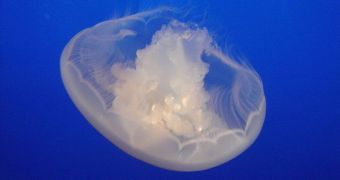Jellyfish are a very peculiar type of marine animals, mostly because not much is really known about their past and their evolution. Their construction leaves very few fossils behind, and only a limited number of specimens are available in natural history museums around the world. The thing that always fascinated people about them was the fact that the small creatures, in spite of their eerie, harmless appearance, were perfectly able to kill a fully grown human. Admittedly, not all species share this ability, as some are fairly harmless. But a new study may help experts looking for antidotes against some jellyfish's potent venom get to their “destination,” LiveScience reports.
The recent study focused on box jellyfish, named thus on account of their shapes. There are a number of species in this class that are capable of killing people within just minutes, thanks to a very powerful type of venom that they have stored in special sting capsules known as nematocysts. The creatures can usually be found in coastal waters around the world, in warm temperatures, which is precisely what human tourists are looking for. This fact may account for some of the accidents that take place between us and these creatures, at regular intervals.
“Knowing who is related to whom among the box jellyfish will be very helpful in making predictions about species that are not well known,” Allen Collins, who is a researcher at the US National Oceanic and Atmospheric Administration (NOAA) explains. He reveals that antivenom created for a single species may very well work for others as well. The lack of fossils means that the kinship between the various species is very hazy. Evolutionary biologists still have very little clues as to which species derived from which predecessors, and other such information that could make the researchers' jobs easier.
“Geography seems to isolate species and most don’t seem to cross open ocean habitats. A few are found in all three oceans and may live in tropical regions around the globe,” the scientists say in a statement. Details of the investigation appear in the latest issue of the respected scientific journal Proceedings of the Royal Society. The work received all of its funding from the PADI Foundation, and the US National Science Foundation (NSF).

 14 DAY TRIAL //
14 DAY TRIAL //